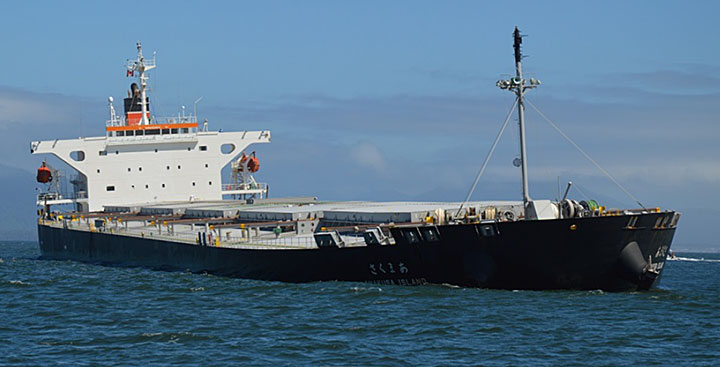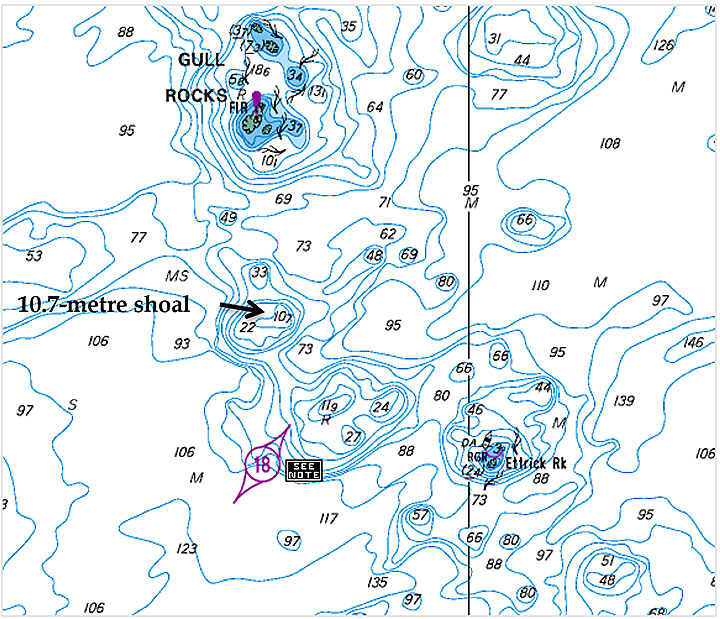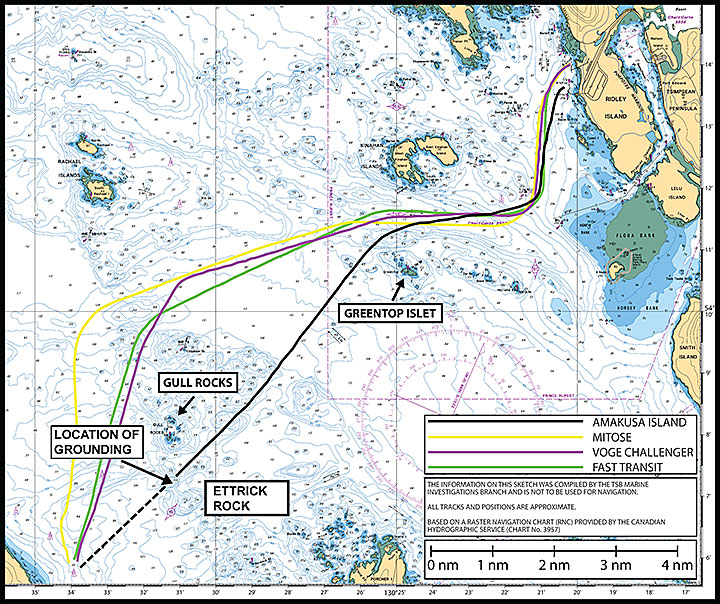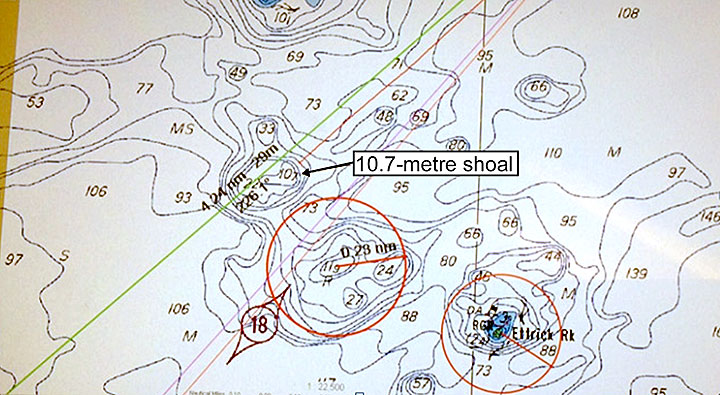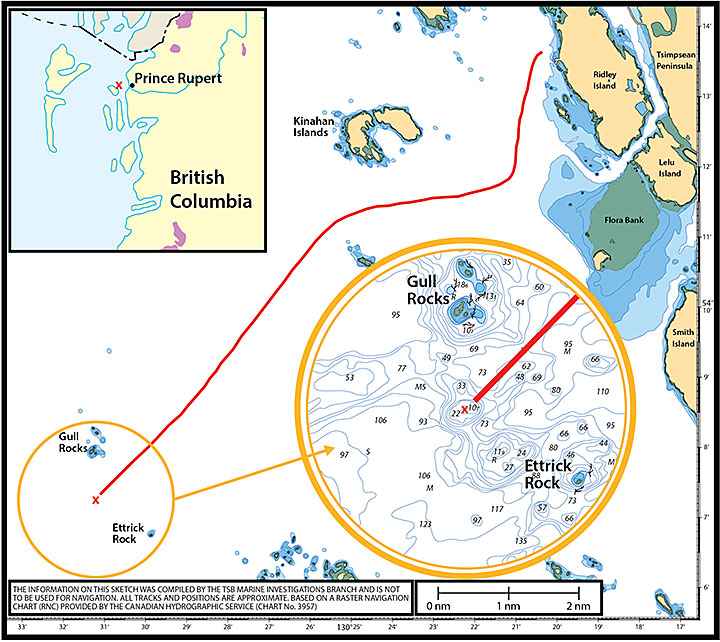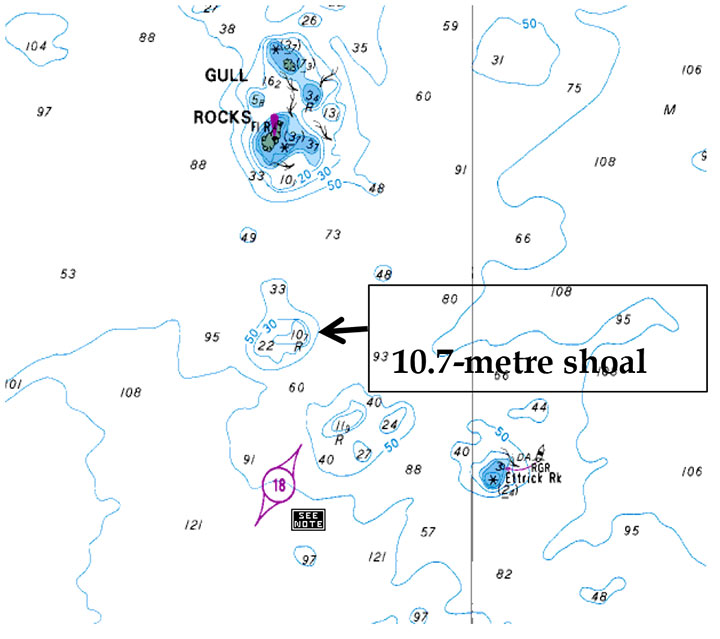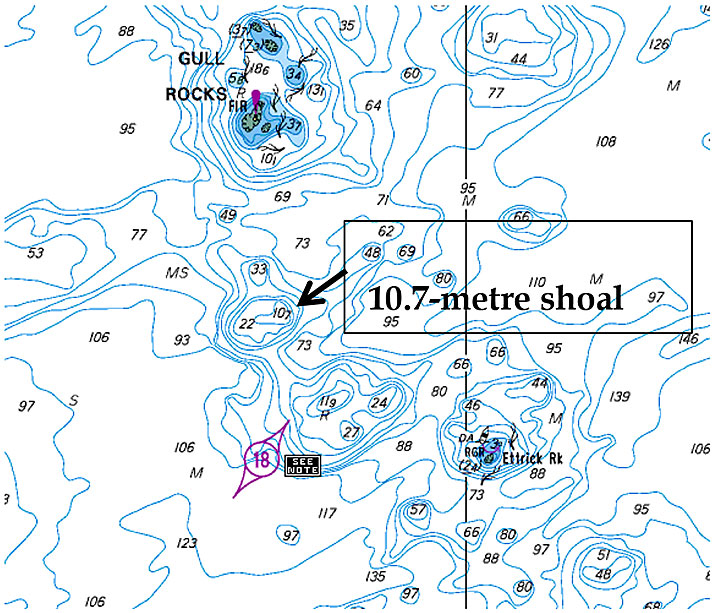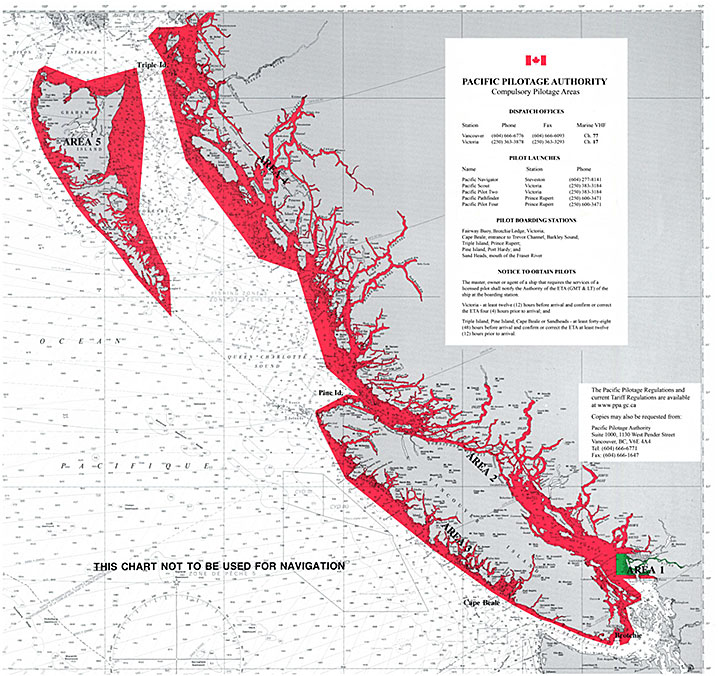Grounding
Bulk carrier Amakusa Island
Prince Rupert, British Columbia
The Transportation Safety Board of Canada (TSB) investigated this occurrence for the purpose of advancing transportation safety. It is not the function of the Board to assign fault or determine civil or criminal liability. This report is not created for use in the context of legal, disciplinary or other proceedings. See Ownership and use of content. Masculine pronouns and position titles may be used to signify all genders to comply with the Canadian Transportation Accident Investigation and Safety Board Act (S.C. 1989, c. 3).
Summary
On 14 July 2014, at 2209 Pacific Daylight Time, the bulk carrier Amakusa Island ran aground on a charted shoal while approaching an anchorage located approximately 11 nautical miles southwest of Prince Rupert, British Columbia. The vessel was under the conduct of a pilot at the time. The vessel refloated on the rising tide approximately 4 hours after the grounding. There were no injuries or pollution, but the vessel sustained damage to its hull.
Factual information
Particulars of the vessel
| Name of vessel | Amakusa Island |
|---|---|
| International Maritime Organization (IMO) number | 9303900 |
| Port of registry | Reihoku |
| Flag | Japan |
| Type | Bulk carrier |
| Gross tonnage | 44 547 |
| LengthFootnote 1 | 228.0 m |
| Draft at the time of the occurrence | Forward: 13.3 m Aft: 13.3 m |
| Built | 2005, Saikai, Japan |
| Propulsion | 1 main diesel engine (9966 kW) driving a fixed propeller |
| Cargo | 80 021 metric tons of coal |
| Crew | 20 |
| Registered owner | Iino Kaiun Kaisha Ltd., Japan and Kyuden Sangyo Co., Inc., Japan |
| Manager | Iino Marine Service Co. Ltd., Japan |
Description of the vessel
The Amakusa Island is a gearless bulk carrierFootnote 2 built of steel with the machinery spaces and accommodation aft (Photo 1). The vessel has 5 cargo holds and hatches. Cargo holds No. 1 and No. 2, which are located closest to the bow, each have double‑bottomed port and starboard ballast tanks beneath them. The ballast tanks are divided along the centreline. Ballast wing tanks and a centre fuel oil tank are below the remaining cargo holds. A bulbous bow and a collision bulkhead enclose the forepeak water ballast tank.
The bridge is equipped with the required navigational equipment, including an automatic identification system (AIS),Footnote 3 2 radars (fitted with automatic radar plotting aid capability), a GPS (global positioning system), and an echo sounder with its transducer located aft. The steering stand is located on the centreline of the vessel. The vessel is also fitted with a voyage data recorder. At the time of the occurrence, the vessel was not fitted with an electronic chart display and information system (ECDIS).Footnote 4
History of the voyage
On 08 July 2014, the Amakusa Island arrived in Prince Rupert, British Columbia and, under the conduct of a British Columbia Coast Pilots Ltd. (BCCP) pilot, proceeded to Anchorage 28 to await the coal berth at Ridley Island, British Columbia.
The berth became available on 13 July and, under the conduct of a BCCP pilot, the vessel proceeded north of Gull Rocks, British Columbia (Appendix A), arriving at the berth at 1235Footnote 5 to commence loading operations.
At 1935 on 14 July, a different BCCP pilot boarded the Amakusa Island while it was in the final stages of loading coal. The vessel was scheduled to depart at 2000, after which time it would proceed to the pilot station off Triple Island, British Columbia,Footnote 6 where the pilot would disembark before the vessel continued on its planned voyage to Japan.
After boarding, the pilot set up his portable pilotage unit (PPU) with a raster chartFootnote 7 for the area, on which he had prepared the passage plan from the berth to the pilot station. The vessel's navigation officer had also prepared an outbound voyage plan, on paper chart No. 4936, published by the United Kingdom Hydrographic Office (UKHO).Footnote 8
At 1959, another vessel, the Katsura, which had been at Anchorage 10 awaiting the berth that the Amakusa Island was occupying, heaved anchor and got underway. Foreseeing a delay in the Amakusa Island's departure, the pilots on both vessels made arrangements for the Katsura to proceed slowly to give the Amakusa Island more time to depart the berth. The Amakusa Island completed loading at 2006. The vessel's draft was checked prior to departure; it was 13.3 m on an even keel.
At 2015, the master‑pilot exchange was conducted, which included discussion of the passage plan from Prince Rupert to Triple Island. The bridge team at that time consisted of the master, the pilot, the third officer as the officer of the watch (OOW), and a helmsman.
Shortly after completion of the master‑pilot exchange, the vessel's charterer directed the master to anchor, as there remained some issues to resolve regarding the cargo before the vessel could commence its voyage to Japan. The pilot and the vessel's agent were advised about the change of plans. The pilot advised the pilot of the Katsura of the change of plans as well.
At 2032, the master was advised that the Prince Rupert Port Authority had assigned Anchorage 25 to the vessel.Footnote 9 With the Katsura still underway toward the berth, the master and the pilot of the Amakusa Island identified Anchorage 25 on the chart. The master and pilot then continued to prepare the vessel for departure in order to get underway and free up the berth for the other vessel.
The Amakusa Island departed the berth at 2045 with the assistance of 2 tugs. At 2057, the pilot informed the Prince Rupert Marine Communications and Traffic Services (MCTS) Centre that the vessel would proceed to Greentop Islet, British Columbia, and then to Anchorage 25.
At 2132, the pilot advised MCTS that the vessel was at Greentop Islet and that they would call in again when the vessel was at the anchorage. After the vessel rounded Greentop Islet and was on a steady course to the anchorage, the master used the vessel's paper chart to plot a direct course line from Anchorage 25 back to the alteration point near Greentop Islet. The course line passed between 2 navigational hazards that the bridge team had marked on the chart: Gull Rocks and an 11.9-metre shoal, both of which were roughly 0.4 nautical mile (nm) from the course line. The pilot verified the course line the master had plotted to ensure that the correct anchorage had been identified and that there was sufficient water depth along the course line. The shallowest charted depth along the course line was determined to be 22 m.
Having set up the PPU using a raster chart with a dynamic range and bearing line (DRBL), the pilot was able to monitor the vessel's speed over ground (SOG) and time of arrival at the anchorage. Once on DRBL, the pilot set the PPU to follow‑up mode, which displayed the vessel as a stationary icon on the screen while the chart scrolled beneath it.
At 2148, the vessel was 5.7 nm from the anchorage, and the pilot ordered half ahead on the main engine. The vessel's speed at this time was 8.3 knots SOG.Footnote 10 Meanwhile, the master had sent the chief officer and 2 crew members forward to prepare for anchoring. At 2156, the pilot ordered slow ahead on the main engine and, a minute later, ordered dead slow ahead.
At 2200, the OOW, who had been monitoring by radar and plotting the vessel's position, plotted a position on the chart using a range and bearing from Gull Rocks. The vessel was approximately 0.10 nm south of the vessel's charted course line on a heading of 224.8° T (degrees true).Footnote 11 Five minutes later, the OOW plotted the vessel's position as 0.05 nm south of the vessel's charted course line. At 2206, the vessel passed abeam of Gull Rocks at a speed of approximately 6 knots and on a heading of 226.7° T.
At 2209, a shudder was felt on the vessel and the vessel's speed decreased. After confirming that the anchor had not been accidentally released, the pilot ordered the main engine stopped and ordered the OOW to plot the vessel's position on the chart while he verified the position on his PPU. At this time, it was observed that the vessel's echo sounder was indicating a depth of 27 m below the keel. Shortly after, water could be heard entering the double-bottomed tanks through the deck vents.
The master ordered the crew to sound all the tanks, and the pilot advised MCTS of the situation. The tug SmitStarFootnote 12 arrived at 2228 and was asked to take depth soundings around the vessel. Approximately 10 minutes later, after the master and pilot had examined the chart in detail, it was confirmed that the vessel was aground on a shoal with a charted depth of 10.7 m. The vessel was in position 54°07.308' N, 130°31.042' W, approximately 140 m south of the plotted course line (Appendix A).
At 0045 on 15 July, the harbour patrol vessel CharlesHays, operated by the Prince Rupert Port Authority, arrived on scene to assess the situation. After the vessel's tanks were sounded, it was determined that the forepeak tank and the starboard ballast tanks No. 1 and No. 2 had sustained damage and were taking on water. The chief officer calculated new drafts for the vessel,Footnote 13 taking into consideration the water ingress in the holed tanks, and provided this information to the pilot. After sounding around the vessel, the SmitStar assisted the vessel in maintaining a constant heading to limit further damage that could occur if the vessel pivoted on the shoal. At 0145, the pilot boat PacificPathfinder arrived with a relief pilot. A short time later, a larger tug, the Smit Clyde, arrived on scene and replaced the SmitStar.
At approximately 0225, the vessel refloated with the rising tide and moved aft, clear off the shoal. Under the conduct of the relief pilot, the vessel proceeded under its own power, with tug escort, to Anchorage 16 for further assessment. Later that day, divers assessed the damage to the vessel and began carrying out repairs.
By 08 September, temporary repairs had been completed under the guidance of the vessel's classification society, and the vessel departed the next day for Japan.
Damage to the vessel
The damage to the vessel consisted of
- a longitudinal crack (approximately 30 cm long and 2 cm wide) on the forepeak tank bottom plating at frame 227;
- a longitudinal crack (approximately 12 m long and 50 cm wide) on the bottom plating, 8 m from amidships on the starboard side, which extended from the forepeak tank to water ballast tank No. 1, between frames 224 and 210;
- a longitudinal crack (30 m long and 100 cm wide) on the bottom plating, 6 m from amidships on the starboard side, which extended from water ballast tank No. 1 to water ballast tank No. 2, between frames 210 to 178;
- a transverse crack (50 cm long) located at frame 180.
Personnel certification and experience
The master held Master Mariner certification issued in 2004 and had been promoted to the position of master in 2007, joining the Amakusa Island in May 2014. He had completed bridge resource management training in May 2011. The master had started sailing as a cadet in 1989. This was the master's first voyage to Prince Rupert.
The OOW held a certificate for Officer in Charge of a Navigational Watch issued in July 2007, and also had Deck Rating and Able‑bodied Seaman certification. He had sailed on bulk carriers since 2008, joining the Amakusa Island in October 2013. This was his first voyage to Prince Rupert.
The pilot on the Amakusa Island held a Class I pilot licence issued in 1995. He also held a Master, 500 Gross Tonnage, Near Coastal certificate issued in 2013 and a Master, Ship of Not More Than 350 tons Gross Tonnage, or Tug, Home-trade Voyage issued in 1974. He had started his seagoing career in 1966 on tugs and had significant experience as a towboat master in the Prince Rupert area. The pilot had completed a bridge resource management course in 1998 and PPU training in 2010 and 2014.
Vessel certification
The Amakusa Island was certificated and equipped in accordance with existing regulations.
Environmental conditions
At the time of the occurrence, the sky was clear and there was a light westerly wind. Sunset was at 2208, with civil twilight ending at 2259. Low tide for Prince Rupert was at 2202, at which time the tidal height was 1.3 m. The next high tide for Prince Rupert on 15 July 2014 was at 0406, at which time the tidal height was 6.9 m.
Navigational chart
The chart in use on board the Amakusa Island was UKHO Chart 4936, which is an exact replica of Canadian Hydrographic Service (CHS) Chart 3957. The pilot was using a raster chart on his PPU that depicted the same data as CHS Chart 3957.
CHS Chart 3957 depicts the shoal on which the Amakusa Island grounded using bathymetric lines. The number of bathymetric lines around the 10.7-metre shoal indicates that the seabed rises at this location. The shoal is also marked with a 10.7-metre sounding measurement (Figure 1). The shoal is not shaded or tinted because its depth is greater than 10 m (for depths less than 10 m, the CHS adds blue tint or shading). With depths that have a decimal value associated with them, the decimal value is depicted by a subscript number, in this case “107.” The sounding measurements are printed in 7-point font.
An 11.9-metre shoal just to the south of the 10.7-metre shoal is depicted on the chart and marked with an “R” to indicate a rocky bottom composition.
The CHS also publishes Chart 3956, which is a newer edition that covers the same area as Chart 3957. See Appendix B for a comparison of these 2 charts.
Sailing directions
The sailing directions for the south part of Chatham Sound, British Columbia (Chart 3957) state that a 10.7-metre shoal lies midway between Ettrick Rock and Gull Rocks and that a starboard bifurcation buoy “DA” is close to the northwest of Ettrick Rock.Footnote 14
Pilotage services
On the west coast of Canada, the operation, maintenance, and administration of pilot services for compulsory pilotage areas is the responsibility of the Pacific Pilotage Authority (PPA), a Crown corporation. The PPA contracts a private company, the BCCP, to provide pilotage services within its compulsory pilotage areas. The BCCP consists of approximately 105 licensed marine pilots. Of those, approximately 60 are based in the Vancouver, British Columbia area, 40 are based in the Victoria, British Columbia area, and 5 are based in the Nanaimo, British Columbia area.
There are 5 compulsory pilotage areas set out in the Pacific Pilotage Regulations. Area 1 is defined as the Fraser River and other rivers flowing into it. Areas 2 to 5 (Appendix C) cover the compulsory pilotage areas for the coast of British Columbia and can be defined as follows:
- Area 2: the waters between mainland British Columbia and the east coast of Vancouver Island from Juan de Fuca Strait to Pine Island
- Area 3: the waters west and north of Vancouver Island to Pine Island
- Area 4: the mainland coastal waters of British Columbia north of Pine Island to the southern border of Alaska
- Area 5: the waters surrounding Haida Gwaii
Combined, these areas cover the entire British Columbia coast, extending approximately 2 nm from every major point of land. This pilotage area stretches from Alaska in the north to Washington State in the south and is one of the largest in the world.Footnote 15
Pilot licensing
The PPA sets the hiring and training requirements for apprentice pilots.Footnote 16 The apprenticeship lasts from 9 to 24 months and consists of a variety of training courses, including ship handling, escort tugs, and ECDIS. In addition, the apprentices perform pilotage assignments with licensed pilots into all the ports on the British Columbia coast and are subject to periodic assessments conducted by senior pilots. Apprentices must also complete written and oral examinations to demonstrate local knowledge of the area(s) for which they wish to obtain their licence.Footnote 17 Upon successful completion of the apprenticeship, a Class II licence (restricted) is awarded to the new pilot. To obtain a Class I licence (unrestricted), a pilot must have served satisfactorily as the holder of a Class II licence for a period of 1 year. For the next 6 years, a Class I pilot is progressively assigned various vessels of increasing tonnage, at the end of which a pilot receives “unlimited” status.
Once BCCP pilots obtain their Class I pilot licence, they are authorized to pilot vessels along the entire British Columbia coast with the exception of the Fraser River, which is restricted to pilots licensed for Area 1 only. Of the approximately 105 licensed BCCP pilots, 93 hold Class I licences. The licence remains valid as long as the pilot passes the Transport Canada marine medical examination every 2 years.
International Maritime Organization (IMO) Resolution A.960(23)Footnote 18 states that each applicant for a pilot certificate or licence should demonstrate the necessary knowledge of various factors for the waters in which they are to be certified or licensed. These factors include, but are not limited to, the following:
- names and characteristics of the channels, shoals, headlands and points in the area;
- depths of water throughout the area, including tidal effects and similar factors;
- proper courses and distances in the area;
- anchorages in the area.
Pilotage in the Prince Rupert area
To provide pilotage services for the Prince Rupert area, the BCCP stations pilots with Class I licences in Prince Rupert on a rotational basis. Generally, there are 3 pilots—2 with the unlimited status (over 6 years of experience) and 1 with the limited status (over 3 years of experience)—stationed in Prince Rupert per week; however, these numbers may vary depending on vessel traffic. These pilots are responsible for the pilotage of vessels in Areas 4 and 5, which includes 31 anchorages in the Prince Rupert area.
According to the PPA, in 2012, there were 12 946 pilot assignments in its region. Of these, 402 were assignments in Prince Rupert. In 2013, there were 468 pilot assignments, and in 2014, there were 454. On average, pilots stationed in Prince Rupert spend 1 week there before rotating out. Over the course of a year, a pilot generally spends about 2 to 3 weeks in Prince Rupert.
The occurrence pilot's assignments in the Prince Rupert area for the 6 years preceding the occurrence were as follows:
| Year | Number of assignments |
|---|---|
| 2009 | 14 |
| 2010 | 6 |
| 2011 | 12 |
| 2012 | 12 |
| 2013 | 0 |
| 2014 (up to occurrence date) |
10 |
The occurrence voyage was the pilot's first assignment piloting a vessel from Prince Rupert to Anchorage 25. Prior to this occurrence, the pilot had not piloted to any of the southern outer anchorages, nor had the pilot taken the route passing south of Gull Rocks previously.
Previous voyages to Anchorage 25
Records from the Canadian Coast Guard's Vessel Traffic Management Information System (called INNAV or VTMIS-INNAV) indicate that the occurrence voyage was the first time a vessel under the conduct of a pilot had taken the route passing south of Gull Rocks on its way to Anchorage 25 since November 2012.Footnote 19 Since 2012, three other vessels, Mitose, VogeChallenger, and Fast Transit, had sailed from Prince Rupert to Anchorage 25 with pilots on board. On all 3 occasions, the vessels took a route that passed north of Gull Rocks (Figure 2).
The route that passes south of Gull Rocks is approximately 1.5 nm shorter than the route to the north.
Voyage planning
According to the IMO, all vessels should complete a voyage plan in order to ensure the safe passage of the vessel on its intended voyage.Footnote 20 Voyage planning includes the following:
- Appraisal of all available information relevant to the intended voyage should be considered. Among other things, this includes obtaining accurate and current sailing directions and charts (of an appropriate scale); reviewing the relevant charts and publications; reviewing any relevant Notices to Mariners; and gathering information about environmental conditions.
- Planning the intended voyage based on a full appraisal and identifying areas of danger or where special precautions must be taken.
- Continuously and closely monitoring the vessel's progress against the intended plan throughout the voyage.
The bridge team on the Amakusa Island had prepared a voyage plan for the passage from Prince Rupert to Japan. The voyage plan had been completed using the company form and included information such as waypoints, drafts, distances, calling‑in points, and the safe speed within port limits (i.e., 6 knots).
When the vessel was unexpectedly directed to go to Anchorage 25, the master and the pilot identified Anchorage 25 on the chart and continued preparing for departure. After the vessel had rounded Greentop Islet and was on a direct route to Anchorage 25, the master plotted a course on the chart from the alteration point over Greentop Islet to Anchorage 25. The bridge team had marked both Gull Rocks and Ettrick Rock as areas of danger. The pilot and master had determined that a depth of 22 m was the shallowest point along the course line between Greentop Islet and Anchorage 25.
Pilot passage planning
The PPA and the BCCP leave passage planning to the expertise of the individual pilot, who determines the courses to steer based on experience, local knowledge, and an assessment of the environmental conditions for the voyage. Pilots are not required to have passage plans,Footnote 21 but they will discuss the intended route with the master and indicate go/no-go areas during a transit as part of the bridge resource management process.
The PPA and the BCCP prefer the use of navigational corridors as a simple means to identify the safe areas as opposed to specified routes to follow. They maintain that routing vessels in British Columbia's coastal waters along navigational corridors, where each corridor offers a variety of possible routes, is a more prudent practice than documented passage plans. The corridors allow a pilot to take due consideration of variables such as current, weather, traffic, vessel size and manoeuvring characteristics. At the time of the occurrence, there were no navigational corridors in place to be used by pilots in the Prince Rupert area.
Prior to the occurrence, the pilot had identified various areas of danger on the PPU's raster chart that was in use, notably Ettrick Rock and an 11.9-metre shoal located south of the position where the vessel went aground (circled in red in Figure 3).
Portable pilotage unit
The PPA provides each pilot of the BCCP with a PPU, a portable electronic device that allows the pilot to use electronic charts to assist in the pilotage of vessels. The PPA also provides pilots with an initial 5-day PPU training and 2.5-day refresher training. Neither the BCCP nor the PPA requires pilots to use the software in a particular way, nor does either organization require passages to be planned or a vessel's track to be recorded on the PPU.Footnote 22
The PPU gives a pilot the option of selecting either a vector or a raster navigation chart. A vector navigation chart is an electronic navigational chart (ENC) that is displayed using an electronic charting system (ECS) such as an ECDIS. In addition to providing the vessel's real-time position, the ENC can be programmed to take into account the vessel's particular characteristics, and specific weather and marine traffic conditions. An ENC programmed with these parameters can produce visual and audible alarms to warn of dangers. This allows a user to set alarms, including an alarm to indicate an insufficient underwater clearance during the planning or execution of the voyage. Additionally, the user can adjust the type and level of detail being displayed on an ENC (e.g., the ENC is capable of showing depth contours with associated text suppressed). An ENC also allows the user to zoom in on the chart to show denser data.
A raster navigational chart is essentially a paper navigational chart displayed in an electronic format. It does not have any of the programmable features associated with a vector navigational chart. The safety warnings on raster charts are the same as those that appear on the paper chart itself. Raster charts do not have the capability to show denser data when zoomed in.
The pilot's PPU had both the vector and the raster functionality; however, on the occurrence voyage, the pilot had selected a raster chart to emulate the vessel's paper chart.
Canadian Transportation Agency's Review of Pilotage Issues
The passage of the Canada Marine Act in June 1998 resulted in amendments to the Pilotage Act, and included the following section:
53. (1) The Minister shall, in consultation with each authority, its users, and other persons affected, at the latest one year after the coming into force of this section, review the pilot certification process for masters and officers, training and licensing requirements for pilots, compulsory pilotage area designations, dispute resolution mechanisms, and the measures taken in respect to financial self-sufficiency and cost reduction, and prepare a report on the findings.
(2) The Minister shall have a copy of each report laid before each House of Parliament on any of the first thirty days on which that House is sitting after the Minister prepares it.
In 1999, the Canadian Transportation Agency (CTA) issued a document entitled ReviewofPilotageIssues to the Minister of Transport, which identified pilotage concerns across Canada. Among other things, the report stated the following:
While the shipping industry does not question the professionalism of its pilots[,] (…) [i]t is concerned about the ability of pilots to maintain coast-wide experience with fewer trips to smaller outports and believes that this situation compromises the safety of pilotage services in these less-frequented areas.Footnote 23
The report observed that a structured process should be established to ensure the currency of pilots in all compulsory waters in coastal areas.
The CTA's report also identified concerns about the lack of pilot assessments within the 4 pilotage authorities in Canada.Footnote 24 CTA's Pilotage Review Panel Recommendation No. 9 states that “the pilotage authorities be required to develop and implement a fair and reasonable system for assessing pilots' competence and quality of service, after consultation with interested parties. This assessment process should take place regularly and not less than every five years.”Footnote 25 Transport Canada accepted this recommendation and had tasked the competent authorities with developing a pilot quality assurance system that takes into account the needs and characteristics of their respective regions and with reporting on the progress in the year 2000 and in subsequent annual reports.
IMO Resolution A.960(23) specifies that competent pilotage authorities should ensure, at intervals not exceeding 5 years, that pilots continue to possess recent navigational knowledge of the area to which the certificate or licence applies.
In 2008, the Canadian Marine Pilots' Association and the 4 Canadian pilotage authorities developed a set of guiding principlesFootnote 26 to help implement programs to assess pilot proficiency. The guiding principles were intended to allow authorities to meet CTA's Pilotage Review Panel Recommendation No. 9 and IMO Resolution A.960(23).
There are 9 guiding principles in total, 4 of which are listed below and suggest that pilot assessments be
- applicable to all pilots,
- conducted regularly (not less than once every 3 years),
- conducted using multiple means of assessment, and
- focused on offering specific and practical steps to remedy situations should a pilot's proficiency and/or performance need to be improved.
At the time of the occurrence, BCCP pilots with Class I licences were not required to undergo assessments, but could opt to do so voluntarily. As well, if a pilot has not frequented a specific area within the previous 5 years, the pilot has the option to take a familiarization trip into the area. Although the occurrence pilot did undergo a voluntary skills assessment on 07 November 2013,Footnote 27 there is no record to indicate that he had taken a familiarization trip since first obtaining his Class I licence in 1995.
Other pilotage authorities in Canada have established pilot currency requirements and methods to ensure local knowledge is maintained.
On 21 November 2014, the PPA proposed amendments to section 31 of the Pacific Pilotage Regulations. Among other things, the proposed amendments included the following:
- Conduct assessments of pilots' competence and quality of service not less than once every 3 years and provide proof of the assessment to the authority.
- Ensure that pilots are current for the areas for which they are licensed, and provide proof to the authority that pilots have either been into a location in the last 3 years, completed an observer trip into that area, or conducted the passage on a simulator.
TSB pilotage survey
In 1995, the Transportation Safety Board of Canada (TSB) conducted a survey of Canadian marine pilotsFootnote 28 to identify safety deficiencies associated with teamwork on the bridge, including communications between marine pilots and masters/OOWs. The Board, concerned by the frequency and potential consequences of occurrences involving vessels in Canadian pilotage waters under the conduct of a pilot, carried out a preliminary review of 273 occurrences from February 1981 to May 1992. For each occurrence, the most significant contributing factor was identified. Of the 273 occurrences, 200 were identified as involving human factors, of which 46% involved misjudgment by the pilot or master.
As a result of the preliminary data examination, the Board decided to study in more depth the conditions or practices which lead to such breakdowns, with a view to identifying safety deficiencies.
These were 2 of the key findings of the 1995 survey in terms of communications between pilots and bridge teams:
- With respect to the overall exchange of information between pilots and masters and OOWs, apparently each party was under the assumption that the other knows the necessary information and, if they do not, they will request it.
- Misperceptions that the other party knows about the manoeuvring characteristics of the vessel, or the local conditions and the intended passage plan, can lead to significant misunderstandings and surprises for the bridge team.
Outstanding recommendation
In 1991, the Irving Nordic,Footnote 29 under the conduct of a pilot, ran aground in the St. Lawrence River, Quebec, after the vessel exited the navigational channel. The investigation determined that the vessel had exited the channel due to a course change that had been made prematurely by the pilot which had gone undetected by the OOW. A passage plan was not provided by the pilot to assist the OOW in monitoring the pilotage of the vessel. As a result of this occurrence, the Board recommended that:
The Department of Transport require that the pilotage authorities publish official passage plans for compulsory pilotage waters and make them available to masters to facilitate monitoring of the pilot's actions by the vessel's bridge team.
Transportation Safety Recommendation M94-34
The Board is reassessing the current status of the response to this recommendation, which is rated Satisfactory Intent. The 4 pilotage authorities in Canada have been contacted to solicit feedback on actions taken that specifically address any residual risks that may be associated with the safety deficiency which led to this recommendation being made.
Analysis
Events leading to the grounding
Just as the Amakusa Island was about to depart Prince Rupert, British Columbia, for Japan, the master was unexpectedly asked to anchor the vessel at Anchorage 25. The pilot and the master, neither of whom had been to Anchorage 25 before, located it on the chart. Once the vessel was underway, and had altered to port at Greentop Islet, the master, realizing the pilot's intention to head directly to the anchorage, drew the course line on the chart and the pilot reviewed it. This course passed slightly north of a 10.7-metre shoal on the chart, at a clearing distance of approximately 140 m. This clearing distance was unsafe for the AmakusaIsland given its size and draft, indicating that the shoal had likely gone unnoticed or its depth had been misread.
Furthermore, the chart was not examined in sufficient detail, and sailing directions were not consulted to identify all potential hazards along the new route. When the master drew the course line, it is likely that he intended for the pilot to confirm it based on the pilot's local knowledge. The pilot accepted the master's plotted course line. It is unlikely that either independently verified the navigational hazards on the route.
Moreover, the visual acuity that an individual employs for reading details (such as the depth soundings on the chart which were printed in a 7-point font) can have the effect of narrowing the individual's focus. In this case, the course line drawn by the master intersected several depths, and of these, the pilot and master had determined a 22-metre depth sounding to be the shallowest. The 10.7-metre shoal, which was slightly off the intended course line, may have gone unnoticed or been misread as a consequence of visually focusing to discern the chart details along the course line.
Although the pilot was monitoring the vessel's progress on his portable pilotage unit (PPU), the use of a raster chart precluded available route planning and monitoring features that can assist in the detection of known hazards. The raster chart did not allow for an automated depth alarm to indicate insufficient underkeel clearance. The vessel was fitted with a depth sounder, but the transducer was located aft. Even if it had been fitted forward, it is unlikely that it would have prevented the grounding given the vessel's speed and momentum at the time.
The charted 10.7-metre shoal went undetected by the bridge team during the voyage planning process and during monitoring of the vessel's progress toward the anchorage. As a result, the vessel, with a draft of 13.3 m, ran aground when it passed over the charted shoal of 10.7 m.
Maintaining knowledge of compulsory pilotage areas
Pilots are mariners who have been licensed or certified to provide the service of safely navigating vessels in compulsory pilotage waters. Their expertise stems from their extensive local knowledge of the areas to which their certificate or licence applies. This knowledge is acquired through experience and training, and is maintained by regularly practicing their profession and further training when required.
As no pilots are based permanently in Prince Rupert, the Pacific Pilotage Authority (PPA) assigns pilots to work rotational shifts in this area. A pilot will, on average, spend 2 to 3 weeks per year in Prince Rupert, but there is no requirement for a pilot to perform a minimum amount of assignments in this area or in any of the other compulsory pilotage areas in British Columbia.
To be accepted as an apprentice, candidates must have extensive local knowledge of the British Columbia coast. Apprentices receive further training and assessment before a pilot's licence is issued. However, there are limited strategies in place at the organizational level to ensure that all pilots maintain thorough and current knowledge of the waters in the areas for which they have been licensed, subsequent to their initial training. This is especially relevant to the PPA given the large geographical area of compulsory pilotage waters in British Columbia. While the PPA currently allows pilots to take a familiarization trip if they have not piloted into an area in the previous 5 years, neither the PPA nor the British Columbia Coast Pilots Ltd. (BCCP) has minimum requirements for the number of assignments in any of the compulsory pilotage areas, nor is there a system in place to identify the maximum time period a pilot may be absent from pilotage duties, including absence due to service elsewhere, training, or a medical/physical condition. When individuals receive initial training that they may not be required to use for extended periods of time, there is an increased risk that training transferFootnote 30 will not occur, and acquired skills and knowledge will inevitably decline.
On 31 August 1999, the Canadian Transportation Agency raised concerns about the currency of pilots in all compulsory pilotage waters in coastal areas, and for Prince Rupert specifically. However, at the time of the occurrence, pilots with a Class I licence were not required to undergo assessments but could opt to do so on a voluntary basis. Periodic assessments would provide an opportunity to identify potential problems with currency of local knowledge in compulsory pilotage waters and target refresher training to those that may need it.
If effective strategies to help all pilots maintain thorough and current knowledge of the areas to which their licence applies are not in place, there is a risk that pilots will not be sufficiently familiar with these areas to carry out their duties safely.
Findings
Findings as to causes and contributing factors
- The vessel's destination unexpectedly changed upon departure, and the new route passed in proximity to a charted 10.7-metre shoal.
- The charted shoal was not detected by the bridge team either while planning the revised route or during monitoring of the vessel's progress.
- The pilot's portable pilotage unit was not configured with all available route planning and monitoring features to assist in the detection of known hazards.
- The vessel, with a draft of 13.3 m, ran aground when it passed over a charted shoal of 10.7 m.
Findings as to risk
- If effective strategies to help all pilots maintain thorough and current knowledge of the areas to which their licence applies are not in place, there is a risk that pilots will not be sufficiently familiar with these areas to carry out their duties safely.
Safety action
Safety action taken
Canadian Hydrographic Service
Following the occurrence, the Canadian Hydrographic Service (CHS) updated Chart 3957 by marking an "R" adjacent to the 10.7-metre shoal, to indicate the type of bottom composition as rock or rocky. The Canadian Coast Guard issued a Notice to Mariners (edition 11, dated 28 November 2014) advising of the changes made by the CHS.
United Kingdom Hydrographic Office
The United Kingdom Hydrographic Office issued a similar notice to update Chart 4936 by marking an “R” adjacent to the 10.7-metre shoal, thereby indicating the seabed type (Notice 0141/2015).
British Columbia Coast Pilots Ltd.
The British Columbia Coast Pilots Ltd. (BCCP) has completed safety corridors for all areas of the coast, excluding Haida Gwaii. The corridors for Prince Rupert, British Columbia, were finalized in August 2014, and the central coast to Prince Rupert was finalized in February 2015. The corridors represent areas where it is deemed safe to navigate with consideration to factors such as current, weather, traffic, and vessel size. The area around Gull Rocks, British Columbia, is outside of a safety corridor. All safety corridors data are distributed via a cloud service and installed on each pilot's portable pilotage unit.
On 11 June 2015, the BCCP and the Pacific Pilotage Authority (PPA) reached an agreement to
- require all pilots, regardless of years of service, to undergo mandatory assessments, not less than once every 5 years;
- improve upon the currency program to better monitor individual pilot's assignment history and identify any lapses in currency; and
- create additional opportunities for pilots to obtain recent experience for the areas in question.
Pacific Pilotage Authority
In November 2014, the PPA initiated a joint review committee, which includes members from the marine industry, the BCCP and the PPA, to solicit views from industry stakeholders regarding the current pilotage system and practice, identify existing hazards, and evaluate current defences.
The Joint Review Committee's report was completed and approved by the PPA Board on 30 July 2015.
Iino Marine Services Co. Ltd.
In November 2014, the management company responsible for the Amakusa Island installed an electronic chart display and information system (ECDIS) on board. The company also initiated training for the crew in various aspects of human performance.
This report concludes the Transportation Safety Board's investigation into this occurrence. The Board authorized the release of this report on . It was officially released on .
Appendices
Appendix A – Area of the occurrence
Appendix B – Comparison of Canadian Hydrographic Service charts 3956 and 3957
The following differences are of note: On Chart 3956, there are fewer depth contours and more soundings as compared to Chart 3957. As well, on Chart 3956, the 10.7-metre shoal has the nature of the seabed indicated, using the letter “R” for rock, while on Chart 3957, this was not indicated at the time of the occurrence.
